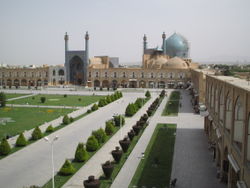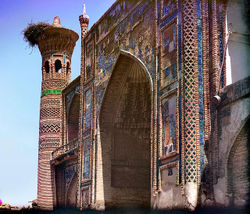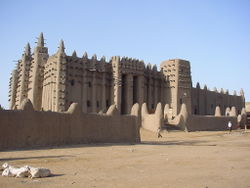 Center of Muslim community
Center of Muslim community
( Click to enlarge - Imam Mosque, formerly Shah Mosque along Naghsh-i Jahan Square in Isfahan, Iran)

Many Muslim rulers after the death of the Islamic prophet Muhammad, emulating him, established their domains by first building a mosque. In the same way Mecca and Medina are built around the Masjid al-Haram and the Masjid al-Nabawi, Karbala, in present-day Iraq, was built around the Shi'ite Imam Hussain Shrine. Isfahan, Iran is especially notable for its use of mosques to form the center of the city.

In the eighth century, a mosque was established within the city which three centuries later was described by theologian and philosopher Naser Khosrow as "a magnificent Friday Mosque built in the city center."

At the dawn of the seventeenth century, Shah Abbas I of the Safavid Dynasty led an effort to establish Isfahan as one of the largest and most beautiful cities in the world. As part of his plan, he ordered the building of Shah Mosque and Sheikh Lotf Allah Mosque which border Isfahan's Naghsh-i Jahan Square, which, as one of the largest city squares in the world, hosted sports and trade.

Mosques built more recently, especially in countries where Muslims are not the majority, tend to be away from the center of major cities. Nevertheless, even a mosque in a less densely populated area often influences Muslims to relocate their homes and businesses so they are close to the mosque. Thus, mosques form the focal points of Muslim communities, even if they do not form the center of the entire community as a whole. In the United States, the growth in the number of mosques and congregants in suburbs is much greater than that in densely urban areas.
 Education
Education

(click to enlarge - The Ulugh Beg Madrassa, which includes a mosque, in Samarkand, Uzbekistan)

Another primary function of a mosque is to house educational facilities. Some mosques, especially those in countries where state-funded Islamic schools are not present, will have full-time schools that teach both Islamic and general knowledge. These full-time schools normally have students in elementary school and middle school, although there are also a few full-time schools available to high school students.

Most mosques will also have part-time schools, either on the weekends or in the evenings. Whereas full-time schools are meant for children who depend on the mosque to provide an Islamic education as well as a general education, weekend and nightly schools are meant to provide only Islamic education for students of all ages, young and old. Some mosques, however, will also provide general educational help to Muslim students as a way of bringing young Muslims closer to the mosque.

The subjects at the Islamic evening and weekend classes vary. Qur'an reading and Arabic are commonly found at mosques that are located in countries where Arabic is not widely spoken. Classes for new Muslims about the basics of Islam are also common, especially in Europe and the United States, where it is the fastest-growing religion.

Mosques will also go into more depth about Islam by providing congregants with classes on Islamic jurisprudence. Madrassas are also available for Muslims to study 'alim to become Islamic scholars or imams. However, as their primary purpose is not to serve as a place of worship or community center, madrassas are normally separate from neighborhood mosques
Events and fundraising

The Great Mosque of Djenné is host to an annual festival.Mosques will host events and dinners either for raising money for mosque activities or simply to bring the community together. Young people are often attracted to mosques that have sports facilities such as basketball courts or fields for soccer or American football. Courtyards at mosques are often used for hosting social gatherings; bazaars where community members can shop for Islamic merchandise are common among mosques. Mosques will also host weddings, much like other places of worship.

One particularly interesting Illustration of this community involvement is that of the mosque in Djenné, Mali where, during an annual festival, the community takes part in the re-applying of plaster to the exterior of the mud brick building (the largest of its kind in the world).

( Click to enlarge - The Great Mosque of Djenné is host to an annual festival. )